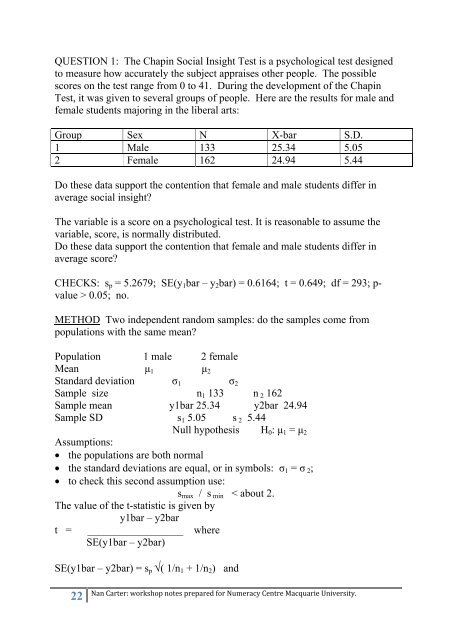STAT170 Workshop Notes prepared by Nan Carter for Numeracy ...
STAT170 Workshop Notes prepared by Nan Carter for Numeracy ...
STAT170 Workshop Notes prepared by Nan Carter for Numeracy ...
You also want an ePaper? Increase the reach of your titles
YUMPU automatically turns print PDFs into web optimized ePapers that Google loves.
QUESTION 1: The Chapin Social Insight Test is a psychological test designed<br />
to measure how accurately the subject appraises other people. The possible<br />
scores on the test range from 0 to 41. During the development of the Chapin<br />
Test, it was given to several groups of people. Here are the results <strong>for</strong> male and<br />
female students majoring in the liberal arts:<br />
Group Sex N X-bar S.D.<br />
1 Male 133 25.34 5.05<br />
2 Female 162 24.94 5.44<br />
Do these data support the contention that female and male students differ in<br />
average social insight?<br />
The variable is a score on a psychological test. It is reasonable to assume the<br />
variable, score, is normally distributed.<br />
Do these data support the contention that female and male students differ in<br />
average score?<br />
CHECKS: sp = 5.2679; SE(y1bar – y2bar) = 0.6164; t = 0.649; df = 293; pvalue<br />
> 0.05; no.<br />
METHOD Two independent random samples: do the samples come from<br />
populations with the same mean?<br />
Population 1 male 2 female<br />
Mean μ1 μ2<br />
Standard deviation σ1 σ2<br />
Sample size n1 133 n 2 162<br />
Sample mean y1bar 25.34 y2bar 24.94<br />
Sample SD s1 5.05 s 2 5.44<br />
Null hypothesis H0: μ1 = μ2<br />
Assumptions:<br />
• the populations are both normal<br />
• the standard deviations are equal, or in symbols: σ1 = σ 2;<br />
• to check this second assumption use:<br />
smax / s min < about 2.<br />
The value of the t-statistic is given <strong>by</strong><br />
y1bar – y2bar<br />
t = __________________ where<br />
SE(y1bar – y2bar)<br />
SE(y1bar – y2bar) = sp √( 1/n1 + 1/n2) and<br />
22<br />
<strong>Nan</strong> <strong>Carter</strong>: workshop notes <strong>prepared</strong> <strong>for</strong> <strong>Numeracy</strong> Centre Macquarie University.
















